|
Montour Railroad
Mileposts
Bridges
and Tunnels
History
Maps
Roster
Mines
Links
Gallery
Working on the
Montour
Schaeffer
Stories
Sposato
Stories
Employees
Railroading
101

|
|
Milepost 31 Hills - Montour #4
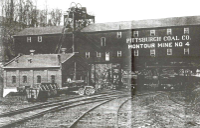 | Read the details of the Montour4 Mine |
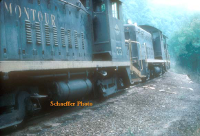
| West
of the loaded yard at Montour #4 was a delrailment that occured
on August 11, 1975. The photo is labeled that the derailment
occurred at 7:25 AM, Engines 77-73-74-75. This scene looks west showing
engines 75 & 74 sitting there, 1000 feet west of the loaded yard
switch. The locomotives are un-coupled as the crew made a vigiliant
attempt in putting em back on the 115 pound rail.
The rerailing
process was terribly complicated as memory serves. The 115 pound rail,
a train of coal coupled to the East locomotive with the derailment
inside the curve of Kamps Cut. Wood blocks are scattered everywhere
which illustrates to me lots of frustration was experienced that
morning. Locomotive journal box's lids are open so the crew knows which
friction bearing brass are out of place and will need adjusted once the
locomotives are back up on the rail. (something I watched many times
but never photographed - jacking a single journal box just a inch or
so, the car department using a steel bar, nudging the errant
journal box brass back into its proper position so the axle isn't cut
and the engine weight is resting properly on each axle...)
Now
look into the shadows beneath the locomotive. Look at the rail,
surrounded by a minature mountain of sand. The story is told, this
railroad hauls tonnage, these SW-9's each day battled the elements of
rickety rail,
hill and dale and tonnage coal trains.
On
the Montour RR, during the last decade of operations, train crews had
no chance at getting that head start at those hills. These train crews
were restricted to 15 MPH and if you were in a slow order, now you were
down to 5 MPH and best not even try to take a run at a hill. The rail
was old and worn out. The roadbed was rotted and wide guage or broken
rails were your enemy. Crews simply, eased into each grade,
throttled up as the weight of all that coal came off the opposing
downhill, and dragging brakes slowly released them selves as the SW-9's
were put to task on taking that Pittsburgh Seam Coal back up the other
side, sanders hissing away as traction motor blowers blew the dust off
the pulverized sand out from under the locomotives.
Many times
all went well. But many times those unique SW-9s...in multiple...simply
tore the train into 2. A broken knuckle...a pulled drawbar...a hi-low
coupler. Sometimes a wheel slip from a low track joint or simply just
the SW-9's loosing their footing starting back up the other side. Now
the train was in 2 pieces and the process was about to begin all over.
Replace the broken knuckle. Remove the defective car with the pulled
coupler. Hi-Low couplers were dealth with by using ties plates or old
track spikes. Sanders going. The train is back together...but don't
just yet put the air back inside em. Not here on this hill, with head
end slack in. Couple back up and step aside. And the "go-ahead" sign
given. The engines throttle out gently. Squealing brakes restrict
speed to a terribly slow speed. Slack is removed ever so slowly. So not
to again break another knuckle. Or pull yet another drawbar. Sanders
are still hissing away as 3 or 4 SW-9's bite into sanded rail.. With
slack removed, nerves tense on the right hand seat box. The brakeman
steps between the cars. And ever so slowly puts the air back in em.
Moments
later, exhaust sounds from releasing brakes.And the SW-9's are back at
work keeping the train stationary as the weight of those 33 or 44 loads
of coal burdens the brakes of the SW-9's. The train is supposed to go
one direction. But the weight...and the nature of gravity suggests
another. The brakeman returns to the engines. Air guages are watched
and the radio crackles from the caboose, Air is releasing. The SW-9's
are nursed forward. Driving wheels under the SW-9's attempt to start
3,000 or 4,000 tons of bituminous. The engineman tense as not to apply
to much power to quickly. And tear this train back apart. Back and
forth the throttle went. Small wheels slips are recognized by the wheel
slip light in the cab. The rail below reverbates from each slip.
Each driver carrying roughly 16 tons of engine weight. Yes, those
SW-9's are just 1200 horses each, and yes they weigh a measly 125 tons in comparison.
Slowly...ever
so slowly...the SW-9's are throttled up. The melody of General Motors
567 diesel engines. Under load with rattling hood doors. And ever so
slowly, that train of coal was taken from a dead stop. And put back
into motion...ever so gently. The ear shattering bangs of car couplers
being stretched and the determination of those quaint little SW-9's
heading em back up the hill. And you wonder, a small mountain of sand,
how meaningless, discareded there on the right of way. Used and
forgotten, but in the eyes of many a much bigger story to tell about those days along the Montour Railroad Company...
Gene P. Schaeffer
| 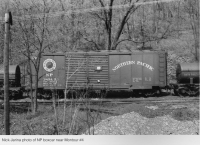 |
Nick
Jarina finds this Northern Pacific box car on the Hill Track,
Pennsylvania Company Transfer Hills. Taken from the main track of the
Montour R.R near the West End Montour #4 Mine in May 1967. - Gene. P. Schaeffer | 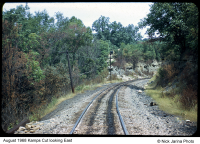 | From the collection of Nick Jarina. Looking East, Kamps Cut, August 1968. Main
track switch indication signal, 1,000 feet west of the West End Montour
#4 loaded Yard at Hills. The wires for the wayside telephone system
still exist. | 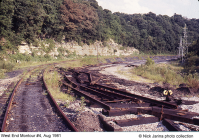 | This Nick Jarina 35mm slide is marked August 1981. Looking East, West End Montour #4 Loaded yard being scrapped.. - Gene P. Schaeffer
Left
Edge - Center of the picture - to the left of the main line tracks - is
a post with what looks like a box attached. This is a bill box used for
conductors to pick up the bills. Look further east and you can
see MP32 leaning toward the loaded yard. A couple of the wayside
telephone pole can be seen, one with a loose cross arm. Note the new
looking ties for the loaded yard. Consol had done a fair amount
of track work around 1979/80, Section #2 gang assisted them with
the switch tie work and lead to the main track. - Tim Sposato | 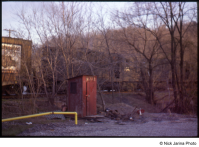 | This
was the On Duty location for section Gang #2. Montour R.R. Section Gang
#2 worked out of Hills Station In this scene the Canonsburg local
(CB-5?) on Conrail passes the location where Section Gang
#2 kept their Hi-rail truck and various work equipment
along with a procured telephone booth which is where the concrete
overpass (seen in the lower right corner) is located on Valleybrook
right at the location where the miners went to work each day. - Gene P. Schaeffer
This
was the new location from the original location at #4 Tipple car
cleaner shanty. The change took place in summer of 1976. The
phone booth was located at the W.E.Hills , between the loaded
yard and main track, about 8 car lengths east of the W.E.
Switch. I think I had posted a short article a few
years ago, about Section #2 needing a storage building for extra
track tools and materials after the move to the #4 Supply Yard took
place. We manhandled the booth from its cross tie base and
loaded it sideways across the sides of the RH-2 truck bed and hi-railed
to Greer’s Crossing to set off. Then drove it to the supply yard
and mounted back onto new cross ties. As I recall, we always had more
than enough extra tools locked in there as well as some tools “stolen”
from other gangs, after we combined forces to work derailments.
This stealing was always a source of finger pointing amongst section
and extra gangs.
I understood the booth stood there for quite
some time after the MRR shut down…..being demolished after Consol Coal
sold the property and the new owner had a lot of landscaping and
grading done. Interesting that this new O.D. location change placed us
across the tracks from the cute granddaughters of “Big” Jim Lane
that lived in the old company store at the underpass, one of them
eventually become my wife. These Nick G. photo’s are really great
to see, he did well on locations and subjects to allow us a look into
the window to the past. - Tim Sposato
The
metal “Hills” sign above the phone booth door was pretty well rusted
away, but some one used a spray can and wrote Hills in its place….this
can be seen in Nicks photo. - Tim Sposato
|  | Its
May 1967 as Nick Jarina aims his camera down the Washington Secondary.
This is Boyce where the Pennsylvania Company Transfer Hills meets the
P.R.R. main line. This track was rebuilt having Boyce siding
(left) connect directly to the Interchangeenabling Montour R.R. crews
the ability to pull empty coal hoppers directly off Boyce Siding without occupying the P.R.R. main track. - Gene P. Schaeffer | 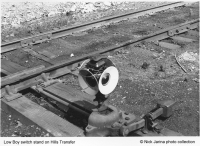 | Nick
jarina aims his camera at the Low Boy switch stand on Hills Transfer in
May 1967. This is the Hill / Creek track switch that is on the lead
coming down off the Montour RR main track. the Montour R.R. main track
is behind Nick Neat to know I have a identical and brand new - never
used Montour RRkerosene switch lamp similiar to this here at home. - Gene P. Schaeffer |
|
|
|
|
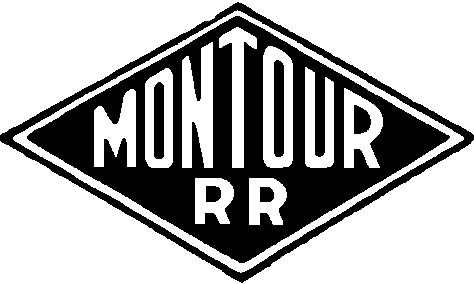 Montour Railroad
Montour Railroad 